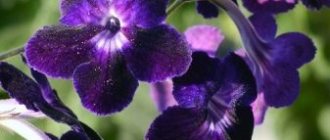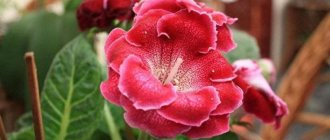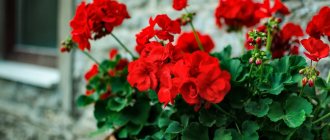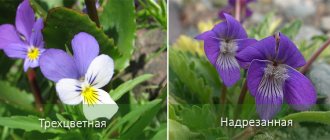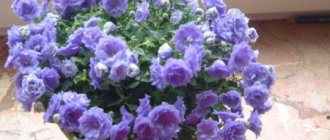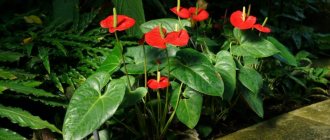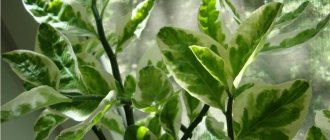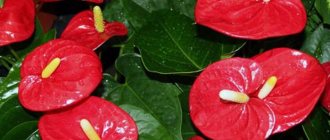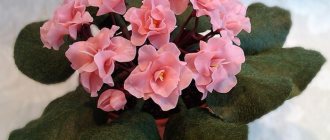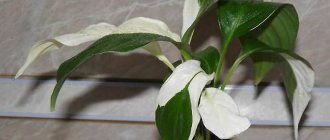Difference between Gloxinia and Synnengia
The reason for the confusion between Gloxinia and Sinningia is their strong external similarity.
The first name was given to the flower, discovered in 1785, in honor of the German botanist Benjamin Peter Gloksin. This type of plant had a scaly rhizome.
A few years later, another species of perennials from the Gesneriev family (with a tuberous root) was discovered. It got its name in honor of the Bonn gardener Wilhelm Sinning.
The reason for the confusion was the discovery of another plant species, which seemed to botanists to be similar to Gloxinia. It was called Gloxinia beautiful, despite the fact that it had a tuber instead of a scaly root.
Botanist's opinion
The only difference between Gloxinia and Synnigia is the type of root. In gloxinias, the root is a rhizome covered with scales, and in Sinningias it is a tuber.
Years later, it was decided to place it in the genus Sinningia due to the shape of the root. But by that time, many varieties for home breeding had been developed on its basis, all of them containing the name gloxinia in their names.
Therefore, today these two botanical terms are actually perceived as synonyms, although they are not so in essence. To combat confusion, the designation floristic gloxinia was invented.
Tydea are also sometimes classified as Gloxinias. But scientists have separated these flowers into an independent genus. The differences between them and gloxinias are in the shape of buds and roots.
Description and varieties
Gloxinia is native to South America. More often it is a low flower, similar to a violet. But there are also varieties that can grow up to 25 cm and higher.
The petiolate leaves of gloxinia reach a length of 20 cm. They have an elongated, oval or ovoid shape. The veins are clearly visible on the plate.
Up to 40 flowers appear on the bush at the same time. And some gloxinia are able to set buds twice a year.
Most Gloxinia indoor flowers cultivated at home are hybrids of the Beautiful and Royal Sinningia. True gloxinias are extremely rare.
Popular gloxinia series include several varieties with different petal colors.
Depending on the crown diameter, gloxinia species are divided into types:
- standard (crown more than 25 cm);
- compact (12 to 25 cm);
- miniature (5 to 12 cm)
- microminiature (up to 5 cm).
Photos and names of gloxinia varieties are shown in the gallery, click to enlarge.
Mont Blanc and Winter Cherry May Queen and Rosalind Kaiser Friedrich Empress Yesenia Hollywood and Black Hollywood Brocade and Impress Chagane and Cleopatra Avanti Kaiser Wilhelm Blanche de Meru Tigrin and Minx
Both simple varieties with one row of petals and double gloxinias are popular in home floriculture.
Although gloxinia is often compared to violets, this flower is different from them:
- the presence of a period of rest;
- larger leaves;
- shape and size of flowers (they are larger and similar to bells);
- smell;
- the presence of a tuber instead of a tap root system.
Varieties of gloxinia with photos and names
There are many different classifications of gloxinia based on appearance. They can vary quite significantly, cover only the size and shape of the flower, or even take into account the nuances of color. There is simply no single classification.
Why everything is so confusing not only in Gloxinia, but also in other representatives of the Gesneriaceae family is difficult to explain. Perhaps because within the genus, crops easily cross with each other and usually produce beautiful hybrids, and a new variety can be developed very quickly.
The classification is really arbitrary; the same flower can often be successfully classified into different categories. It’s generally better not to argue about the size of the bushes. Their size largely depends on the composition of the soil and growing conditions.
Even amateur flower growers who are far from botany can engage in selection and achieve amazing success. It is difficult to predict what will come out of their hands. And then the classification will have to be changed once again.
Comment! Modern varieties of gloxinia are complex hybrids of Sinningia speciosa with other wild species and cultivated varieties.
By color
Gloxinia colors can be very diverse. Often it is designed in soft pastel colors. But it can be so bright and catchy that flower growers with little knowledge of the culture mistake pictures on the Internet or in magazines for Photoshop.
Comment! But there are no yellow gloxinias. They cannot have it due to genetics.
It is customary to classify gloxinia by color depending on how the bud is painted. Perhaps new items will be added to the list soon.
Plain
Everything is simple here: gloxinia is painted in one color. It can be absolutely uniform or slightly different on different parts of the bud. Specks are allowed inside the throat.
Monochromatic ones are no less beautiful than those combining several colors
Bicolor
Bicolor gloxinias, usually bicolor has petals of one color and a border of another. It can be narrow and only frame the flower, or so wide that it is taken as the main color. Terry gloxinias have varieties in which the border covers almost the entire flower, and the pharynx is only visible. The specks are allowed to be inexpressive and only inside the tube.
Bicolors have a contrasting border along the edge of the petals.
Calico
Gloxinias with pronounced specks covering the entire surface of the flower. The dots on one bud can be of different sizes and colors.
Read more: Transplanting gloxinia from one pot to another: in the fall, after purchase, video
Calico gloxinias are painted with specks
Tigers
The combination of bicolor and calico colors in gloxinia is called brindle. Along the edge of the bud there is a pronounced border, inside there are specks of any size and color.
Tigers combine the characteristics of bicolor and calico varieties
By type of buds
Hybrids and varieties of gloxinia tiger, calico, simple plain and bicolor can have one or more rows of petals. Tideas are not terry. At least for now.
Glossy and Internet publications more often publish or advertise photos and names of terry gloxinia varieties. Simple and traditional ones cannot boast of such striking beauty, but they are more delicate and refined.
Simple
Gloxinia with one row of petals. They are usually larger than double ones, and new varieties can have impressively sized flowers.
Simple gloxinias have one row of petals
Terry
A flower with two or more rows of petals. They can be one above the other. But the varieties in which the petals are arranged so randomly that the rows cannot be counted look especially impressive.
Terry species have two or more rows of petals
Tydei
Gloxinias with such buds are related to real Tydaea only in that both genera belong to the Gesnerieceae family. The name of the flower type is derived from its shape. The tube is pronounced, long, ending in five petals, more are rare. The corolla is similar to a bell, convex on one side and concave on the other.
Tydeas look like bells
By bush size
The division of gloxinia by size is also very arbitrary. It is customary to measure not the length of the leaves, but the diameter of the rosette. With the advent of new varieties, changes are made to the classification. Today, gloxinia is usually divided by size as follows, in cm:
- standard – more than 25;
- compact – from 12.5 to 25;
- mini – 5-12.5;
- micromini – up to 5.
Recently, mini gloxinia varieties have become especially popular. There are still few real babes, but the list is constantly growing. Not only botanists, but also amateurs are engaged in crop selection. And it is they who are often lucky.
Miniature types are trending now.
Plant care
Both true and floristic gloxinia (sinningia) come from South America and require the same conditions.
Lighting requirements
Gloxinia is not capricious in terms of lighting requirements. It grows well in diffused light. But it can also be cultivated in partial shade, although the flowers will be smaller.
The recommended length of daylight during the period of bud formation is 12-14 hours.
I keep gloxinia on the north-west windowsill. I noticed that here she feels even better than in a more illuminated place. Irina Petrova, Samara. 3 years of experience in growing gloxinia.
The plant should be protected from direct rays of the sun. Therefore, a flower standing near a south window will need shading.
Signs of a lack of lighting are elongated shoots, pale leaves. You can compensate for the lack of light by lowering the temperature.
During the dormant period, the gloxinia tuber does not require lighting.
Planting and caring for the plant
Planting and growing gloxinia at home is a simple process, but it has its own rules and characteristics.
Preparing the soil and choosing containers for planting
To plant the plant, you can use purchased soil, or you can prepare it yourself. To do this, you need to make a mixture in the following proportions:
- 2 parts leaf soil;
- 1 part peat (can be greenhouse soil);
- 1 part river sand.
The soil should be slightly acidic and breathable, that is, loose. For greater safety, it is recommended to disinfect self-prepared soil. To do this, you can use the drug “Maxim”, which is diluted at the rate of: 1 ampoule of the drug per 2 liters of water. Good drainage is placed at the bottom of each pot.
The root system of Gloxinia is superficial. Therefore, you need to choose a container for planting that is shallow but wide. For normal development, the distance between the walls of the pot and a large tuber should be 4-5 cm, for a small one 3-4 cm is enough. Both clay and plastic dishes are suitable.
Indoor gloxinia TV-Nocturne
Planting a tuber
In February-March, gloxinia tubers can be “awakened” from winter “hibernation”. If they spent the winter in a pot with soil, then the tubers are removed and cleaned of soil. Each tuber is carefully examined, old roots are removed. Rotten areas are carefully cut off with a knife and sprinkled with crushed coal. Before planting, the tubers are dried for 24 hours.
To prevent various diseases, it is advisable to soak the tuber for half an hour in a weak solution of potassium permanganate before planting. After the preparatory processes, the tuber is planted in the prepared container, while deepening it into the ground only 2/3. The pot with moistened soil is covered with film and placed in a place with sufficient lighting.
The planted tuber needs ventilation. Therefore, the film is removed twice a day for 30 minutes. This happens until the first pair of leaves appears. Next, the film must be removed, and the tuber must be sprinkled with 1 cm of soil. In order not to flood it, it is necessary to water it in small portions.
Gloxinia white-red
Lighting
How to care for gloxinia if it is light-loving? Of course, place flower pots in well-lit places. The light should be bright and diffused, but not direct sunlight, from which the flowers quickly fade.
Gloxinia “loves” good and long-lasting lighting. But on a south window it will feel good only in the spring rays of the sun. With the onset of summer, the plant must be shaded or placed on eastern windows.
With the onset of summer, the plant must be protected from direct sunlight.
Temperature
Gloxinia does not tolerate temperature changes well. A temperature of +25° is quite suitable during the germination period of the tuber. After rooting the plant and during the period of growth of its vegetative mass, you can reduce the temperature to +22° - during the day, at night +18° is enough. Lower temperatures will slow down plant development.
To grow gloxinia, it is recommended to maintain a temperature of +22-25 degrees during the day, and at night - not lower than +18 degrees
Air humidity
The period of growth and flowering of gloxinia must be accompanied by sufficient air humidity. With insufficient moisture, plant growth slows down, leaves curl, and buds fade without ever opening.
To maintain the required environmental humidity, flower pots are placed on pallets with wet moss or expanded clay. You can also humidify the air around the plant by frequent spraying with a fine spray bottle. It must be remembered that due to the pubescence of the leaves, direct spraying of the plant is unacceptable! Otherwise, spots will appear on the gloxinia, which will spoil its appearance, which is why it is, in general, grown.
The period of growth and flowering must be accompanied by sufficient air humidity
Watering and fertilizing
Abundant watering is necessary during the growing season of the plant. Settled water, the temperature of which should be 2-3° above room temperature, is poured into a tray or along the edge of the pot. It must be remembered that the water accumulated in the pan will have a detrimental effect on gloxinia.
In summer, it is enough to water the flower 2-3 times a week. From one watering to the next, the soil should dry out. In cold, cloudy and rainy weather, the plant is watered less frequently. Watering begins to be reduced after the end of the flowering period. At the beginning of October, the number of waterings is reduced again. The flower is already beginning to prepare for the dormant period. Gloxinia is practically not watered in winter, but the soil should not be allowed to dry out either.
From April to August, you can please a beautiful home flower with special fertilizers for flowering indoor plants, which are sold in abundance in specialized stores. Feeding is carried out once every 7-10 days, but the dose specified by the manufacturer must be reduced by half. During dormancy, tubers should not be fertilized.
Gloxinia in dew
If you notice that gloxinia does not bloom, then there are reasons for this:
- insufficient feeding;
- bad light;
- oversaturation of the soil with nitrogen fertilizers;
- cold or dry indoor air;
- the flower pot is too large;
- improper care during the rest period.
Try to correct the existing causes in order to resume normal growth and flowering of the plant.
From April to August, the flower must be fertilized every 10 days
Gloxinia hybrid
Rest period
During the year, a flower goes through 3 periods - active growth, flowering and dormancy. The plant's needs at these stages vary greatly.
The dormant period lasts from mid-October to the end of February.
After removing the above-ground part of the plant, the tuber continues to be watered occasionally for another 2-3 weeks. This is necessary so that he gradually plunges into hibernation.
If gloxinia does not want to go to sleep, it needs to be pushed to do so. Watering is stopped completely, and the pot is moved to a cool place.
Storing a tuber of “dormant” gloxinia
You can store dormant gloxinia tubers in 3 ways:
- in a container in sand;
- in a plastic bag;
- in a pot.
The tuber is dug up, shaken off the ground, and treated with a fungicide. When it dries after processing, it is placed in a plastic container filled with sand.
This container is kept in a dark place at a temperature of 10-12°C.
If you decide to use a plastic bag, then fill it with a mixture of earth and vermiculite (1:1). It is advisable to use a zip bag that is fastened and does not allow air to pass through.
Some gardeners keep such a bag with soil and a tuber in the refrigerator, in the vegetable compartment. But botanists believe that temperatures below 10°C are contraindicated for gloxinias.
If you decide to leave the tuber in the pot, then fill it to the top with sand and move it to a dark, cool place. With this storage method, the tuber is watered once every month so that it does not dry out.
In winter, it is best to keep the gloxinia tuber in the basement or garage. Some gardeners place the pot under the bathtub.
The tuber is periodically inspected for drying out and awakening.
The rest period in young gloxinia
In the first year of life, gloxinias grown from seeds do not yet have time to form a tuber strong enough to survive the winter.
The same situation can arise when gloxinia is propagated by leaves or cuttings if they are deepened too deeply into the soil.
Botanist's opinion
You can determine whether a flower is old enough to hibernate by looking at the number of leaves. If there are less than 12, then you cannot send him into the dark.
The pot with such gloxinia is kept at room temperature, periodically watered and illuminated for up to 14 hours a day.
If a flower does not retire on its own, it is not forced to do so.
Flowers that look like violets
The most famous and popular perennial flowers similar to house violets are:
- Achimenes;
- deikun;
- gloxinia;
- Streptocarpus.
Achimenes
If you see that a flower in a pot looks like a violet, then most likely it is Achimenes. The flowering plant resembles a violet with flowers consisting of five petals.
Achimenes.
A striking similarity is noted in the early period of development of the culture , when the plant has not yet become very elongated and sits in a pot as a strong bush. In adulthood, the culture is ampelous. Achimenes petals can be of different colors. Including:
- purple;
- bluish;
- pink;
- light lilac;
- whitish-purple;
- scarlet, etc.
People who grow violets will find it easy to grow achimenes. Decorative culture requires the same care as violets.
Achimenez will feel great in a bright room, but where there is no direct sunlight. It needs high air humidity. To do this, the flower is often placed in the kitchen area.
It should be watered carefully and no more than three times a week. Warm, settled water is suitable for the procedure. The watering can is not directed at the greens; only the root zone is watered.
Stagnation of water should not be allowed. This will cause rotting of the root system. The pot should have plenty of drainage.
Important! Achimenes does not grow in the winter season. In winter, its aerial part dies off, and the pineal rhizome rests.
Deikun
The more famous name of the flower is Cinderella's Dream . The ruffled semi-double edges of the neat petals are reminiscent of a ball gown. This flower is a representative of a new selection of violets. The edges of the petals, which have a terry-net structure, stand out in color from the main petal.
Usually the petal is snow-white in color, and the corrugated edges are covered with a lilac, pink, purple or lilac border. The leaves are moderately velvety, curved-wavy in shape. The upper part of the leaf blade is emerald, the lower part is brick or reddish-green.
Violet Cinderella's dream (Deikun).
Deikun does not tolerate cold, heat, direct sunlight, darkness, or drafts. It is best to keep it in a lighted, ventilated room, where it is about +19…+23 degrees. The soil substrate must be loose. The soil should be moistened every 2 days.
Gloxinia
A violet that looks like a bell is gloxinia, an ornamental crop that resembles a violet with its leaf blades. They are round, slightly elongated, strong. Light velvety pubescence and light veins are noticeable. Leaf color is green.
Gloxinia (close-up photo of the flower).
The leaves do not form rosettes like those of a violet, but grow tightly to each other. The color range of gloxinia is extensive . The prevailing petal colors are:
- lilac-lilac;
- scarlet;
- pink;
- snow-white, etc.
The plant prefers to be in a bright place with diffused bright lighting. The air should not be dry. Otherwise, the stem and leaves with flowers will wither.
Like violets, gloxinia should not be sprayed with water from a spray bottle. To humidify the air, it is recommended to place a container of water in the room. Due to the inadmissibility of drops getting on the green mass, gloxinia should be watered at the root or pour water into a pan.
Gloxinia needs hibernation every year. The dormant period begins in the fall. At this time, the bush is pruned, and the pot is placed in the basement or underground, where it is dark and cool.
Tubers need moisture even in winter. They should be watered once every 20-35 days.
Advice! The culture is responsive to feeding. It is recommended to apply mineral fertilizers to the soil every 50 days, which contain no nitrogen or very little of it.
Streptocarpus
A bright decorative specimen that attracts attention with its fancy miniature neat flowers. The color can be very different - from blue, dark burgundy to snow-white and pinkish.
Streptocarpus.
This indoor plant blooms in the summer . For good growth, a lighted place is necessary. It would be ideal to place it on a windowsill facing east.
The plant is resistant to short-term drought and quickly recovers after watering. It is best to water it every 2-3 days through a tray. In winter it goes to rest.
Awakening of tubers
Gloxinia tubers begin to wake up at the end of February. At this point a transplant is required.
A tuber that has not yet awakened (there are no new growth points) cannot be planted in the ground and watered, it will simply rot.
If the tuber looks healthy, then it is given several weeks to wake up on its own.
Healthy and rotten tubers
If this does not help, you need to wake up the flower:
- The tuber is treated with a growth stimulator and placed in a plastic bag with wet peat.
- The bag is tightly closed and kept under bright, diffused sunlight or under a phytolamp at a room temperature of at least 24°C.
- It takes 1-2 weeks for the tuber to awaken, during which time the bag is not ventilated.
A sign that the gloxinia tuber has sprouted and is ready for planting will be drops of water on the bag. When they appear, the tuber is immediately moved into the ground.
Sometimes the tubers rot during wintering or they cannot be awakened. This does not always indicate poor care for gloxinia at home.
Botanist's opinion
The reason for this is often that many varietal gloxinias sold in flower shops have weak roots.
Such varieties are selected by breeders for their highly decorative flowers and are intended for cultivation as annuals.
The same situation occurs if last year the flower was over-watered with growth stimulants.
If the tuber has sprouted but has lost its elasticity, it is also not planted in the ground. First you need to “reanimate” him. You can do this in 3 ways:
- hold in a solution of a stimulant, for example Zircon (10 drops per 200 ml);
- wrap in damp cloth;
- plant in moist vermiculite.
The tuber is placed in the ground only when it becomes elastic again.
Gloxinia varieties with photos, names and descriptions
It is difficult to make a selection of varietal gloxinias - their diversity can amaze even a sophisticated or oversaturated gardener. Each is good in its own way and has fans.
When purchasing a plant, the following information will be useful:
- Varietal gloxinia can reproduce by seeds. Compliance – 80-100%. From plants that go beyond the varietal description, amateur breeders create new cultivars.
- Hybrid gloxinia can only be propagated vegetatively.
- Industrial varieties are grown en masse, they are easy to breed, and they are the ones sold in stores. They can be no less beautiful than the original ones.
Comment! Collectors usually hide their love for industrial varieties and do not exhibit or show them. This is the way it is in their community. Although for many, the passion for gloxinia, which reaches the point of fanaticism, began with an industrial variety purchased in a store or received as a gift.
Avanti
A popular series of varieties of Japanese selection. A beautiful symmetrical rosette with small leaves with a diameter of no more than 25 cm, it belongs to the compact gloxinia. The flowers are large. With good care, the plant can produce 10-15 buds at a time. The pedicels are long.
Read more How to grow Gloxinia from seeds at home
Popular varieties of the Avanti series: Light Violet with petals of the corresponding color, White - white flowers with sinuous edges, Blue Lace with a light edging, Scarlet - crimson-red gloxinia.
Avanti Scarlet is especially beautiful
Cleopatra
Gloxinia-compact, double flowers, with wavy edges, on short stalks. Pharynx purple. Inside, its color is continuous, as it moves towards the petals it turns into a dense mesh made up of strokes. The flower itself is white, decorated with lilac-raspberry peas. There are fewer of them at the edges of the petals than in the center.
Bouquet type flowering.
The flowers of the Cleopatra variety are white with purple specks
Hollywood
Industrial hybrid of standard size, released in 2003. The peduncles are long, the leaves have a silver tint.
The buds are simple, completely monochromatic. The flowers are purple, about 7 cm in diameter. The edge of the petals is wavy. There is a variety called Hollywood Black with very dark buds. Reproduces vegetatively.
The Hollywood variety is almost black in color.
Starry Sky
Extraordinarily beautiful terry gloxinia by N. Grishina. Blue-violet buds rise on strong peduncles. The edge of the petals is smoothly colored, but not edged. White peas with a dark dot inside are scattered on them. As they move from the periphery to the center, they become denser and larger, merging at the pharynx. The inside of the tube is white. The edge of the petals is wavy.
The Starry Sky species has purple flowers with white speckles
Anfisa
Terry large-flowered tiger by N. Tkachenko. The edging of the petals is crimson and wide. The flower itself is white, dotted with bright peas of the same color as the edge. In the pharynx the specks become smaller. The inside of the tube appears yellow, but is actually light green.
Peduncles are short, stable.
Anfisa is one of the most beautiful tiger
Negress
Very large single-color terry gloxinia. Authorship belongs to N. Grishina. Flowers up to 12 cm in diameter. The color is blue-black, with a transition at the ends of the petals. It seems that the color there is not a little lighter, but simply the surface “plays” under the light.
Standard bush, olive leaves with light veins, large.
The color of Gloxinia Negro depends on the intensity of light and the acidity of the substrate
Strawberry Shake
Large terry gloxinia by O. Artemova. The color of the flowers seems strawberry, but in fact it is white. The petals are simply surrounded by a very wide border, turning into frequent polka dots. In the throat, the specks turn into dots and are arranged in longitudinal rows, which is clearly visible in the photo. The very edge of the petals is highlighted.
The leaves are green. The variety was created in 2012.
Gloxinia Strawberry Shake is actually white, it just has a very wide border
The Snow Queen
Terry gloxinia with cup-shaped buds by E. Statsenko. The petals are white, the throat is lilac. A thin light purple border stretches along the edge of the flower. Sometimes irregularly shaped spots of the same color appear on the petals, which only adds to the charm of gloxinia.
Standard socket. The year of creation of the variety is 2009.
The Snow Queen's blurry colored spots make her different from other gloxinias
Yesenia
An industrial Dutch hybrid with bouquet-type flowering, launched into production in 2008. Standard rosette. When the terry corollas are not fully opened, they resemble pink buds. The color of the flowers is crimson or crimson, at first it seems monochromatic. When fully expanded, a pink or white thin border appears.
Read more Reproduction of gloxinia by leaf at home step by step with photos and videos
The leaves are green. Peduncles are short.
Not fully opened flowers of Gloxinia Yesenia look like pink buds
Tigrina Red
Dutch hybrid. It reproduces only vegetatively, even if it sets seeds. A simple white flower with a diameter of 10-12 cm is decorated with a border, the color of which can vary from crimson to pinkish-red. The inside of the petals is decorated with small, frequent specks of the same color. The corolla appears red with a white coating.
Flowering bouquet. During the season, up to 100 buds can open on one gloxinia Tigrina Red.
Tigrina Red - a typical industrial gloxinia
Winter cherry
Classic calico gloxinia. Mini variety, known since 2007. Double flower, white with large cherry peas. It evenly dots the petals, only becoming a little sparser closer to the edge. The bud resembles a rose. The leaves and edges of the petals are wavy.
Gloxinia Winter Cherry has very beautifully shaped buds
Violacea
Gloxinia with a classic flower of Dutch selection. The size of the bush is standard, the corolla is bell-shaped, 8 cm in diameter. The peduncle is long, too thin and weak to raise a bud. A prop is required for support. The petals are purple, simple, with a white speckled throat and wavy edges.
Comment! This is an excellent variety for beginning gloxinia lovers. It is unpretentious and easy to care for.
Gloxinia Violacea has flower stalks that are too weak to support the weight of the buds
Kaiser Friedrich
Cute gloxinia with olive leaves. Typical bicolor. The flower is crimson, with a wide white border. The inner part of the throat is darker than the petals. At the very bottom of the tube there is a noticeable white spot with crimson specks.
Gloxinia Kaiser Friedrich – crimson, with a wide white border
Kaiser Wilhelm
The peculiarity of the variety is late flowering. Buds appear only on a 3-4 year old plant. The flowers are simple, bell-shaped, bicolor, about 9 cm in diameter. The border is wide, white. The inside of the corolla is dark purple, becoming lighter in bright sun. The bottom of the throat is white, speckled.
Peduncles are tall and strong.
Feature of Gloxinia Kaiser Wilhelm - late flowering
Prince Albert
Gloxinia compact with simple but very showy flowers. The corolla is richly inky, slightly lighter along the edges of the petals than in the center. Inside the throat, the color again becomes more muted, then white with dark blue speckles. The edge of the petals is corrugated. 6 or more buds can open at the same time.
Gloxinia Prince Albert flower has a rich color and beautiful shape.
Blanche de Meru
Gloxinia standard with bouquet flowering - up to 20 erect buds are formed on it at the same time. Not everyone likes this type of bush, but Blanche de Meru is very impressive.
A snow-white bell-shaped corolla with 5 petals is surrounded by a deep pink rim that occupies half of the flower. It does not go in a continuous clear or shaded stripe, like most gloxinia bicolors. It seems as if raspberry syrup was dropped into thick sour cream, and it began to slowly blur. Some gardeners use the comparison “blood and milk” when describing a variety. The inside of the throat is also snow-white, without foreign inclusions.
Blanche de Meru is liked even by those who do not like bouquet gloxinias
Transfer
It is recommended to replant the gloxinia tuber annually at the end of the dormant period (last days of February - beginning of March).
For gloxinia, take light and loose soil. Soil mixtures designed for violets or begonias are best suited. Recommended pH is 5.5-6.5.
I take violet soil and add perlite to it (about a quarter of the pot's volume). This makes the substrate more loose. Zemfira Khasanova, Novy Urengoy. 4 years of experience in growing gloxinia.
When preparing it yourself, mix leaf soil, sand and peat in a 2:1:1 ratio.
Scraps of polystyrene foam or wine cork, or eggshells are used as drainage. It is better not to use expanded clay. The drainage layer must be at least 3 cm.
To plant gloxinia, take a low but wide pot. Its diameter should exceed the size of the tuber by 5-6 cm.
Step-by-step instructions for transplanting gloxinia:
- The tuber is removed from the container where it was stored during the winter.
- It is cleaned of remnants of dead roots and inspected.
- If rotten areas are found, they are cut off with a clean tool and sprinkled with coal.
- If there are many sprouts on a tuber, the least strong ones are broken off. It is best when gloxinia has only one growing point.
- For additional disinfection, the tuber is placed in a solution of potassium permanganate for half an hour. For better germination - in a solution of a growth stimulator. But the top with the growing points should not get wet.
- Dry the tuber after soaking (about a day).
- Drainage and substrate are poured onto the bottom of the pot (about ⅔ of the height).
- The tuber is placed in the ground with the concave part up and covered with soil so that the growing points remain open.
- The flower is watered, covered with film and placed in a warm, bright place.
The tuber should not be completely buried at the time of planting. It is buried approximately ⅔. When the first leaves appear, add soil to the pot to cover the growing points.
The pot with the gloxinia tuber is ventilated twice a day, morning and evening. When leaves appear, the film is removed.
In the video below you can see how an expert from the Garden World channel plants gloxinias.
Problems when growing gloxinia
By the way gloxinia looks, you can guess what care rules the grower is violating.
The consequences of common errors are shown in the table.
| Problem | Probable Cause |
| Yellowing of leaves near veins | Nitrogen deficiency |
| Yellowing of the entire leaf blade | Overwatering Watering with hard water Sun fading Dry air |
| Falling buds | Sudden temperature change Draft Dry air |
| Leaf discoloration | Lack of lighting Lack of magnesium in the soil |
| Brown spots on leaves | Phosphorus deficiency |
| Curling leaves | Dry air Direct rays of sun Excess potassium in fertilizing |
| Rotting stems and buds | Waterlogging at low temperatures Too acidic soil Excess nitrogen |
| Drying leaves | Potassium deficiency |
| Spots on petals | Contact with water droplets |
| Serrated edges along the edges of leaves | Boron deficiency |
| Redness of leaves | Lack of potassium and phosphorus |
| Brown spots on leaves | Watering with cold water Draft Sunburn |
| Unopened buds | Lack of lighting |
| Green peas in place of a bud | Too cold wintering Lack of feeding |
Diseases and pests
Gloxinias are characterized by the same diseases and pests as most indoor plants.
Infection usually occurs through contaminated soil or dirty tools. But development is also facilitated by unfavorable conditions for keeping the flower.
| Photo | Disease | Signs | Provoking factor |
| Late blight | Brown spots on the leaves Mold on the back of the leaves | Stagnant water Dense soil Low temperature | |
| Fusarium | Leaves turn brown and curl | Air humidity more than 85% Lack of water and fertilizers | |
| Gray rot | The stem turns black There is a gray coating on the buds and leaves | Flower overflow | |
| Powdery mildew | White coating on leaves Deformed buds | Cold and high humidity | |
| Rust mushroom | Yellow spots on leaves Bubbles on the back side | Keeping in a musty and cold room during the growth period | |
| Anthracnose | Brown spots on leaves | Lack of phosphorus and potassium | |
| Phyllosticosis | Spots on leaves Leaf breaks at spots | Poor plant immunity |
The listed diseases, as well as root rot, are treated with fungicides (Topaz, Fundazol, etc.) Copper sulfate solutions are often used.
First remove the affected parts of the plant. Additionally, a transplant is recommended.
Gloxinia is considered quite resistant to pests. Occasionally she is struck by:
- spider mite;
- cyclamen mite;
- thrips;
- scale insect;
- whitefly;
- mealybug.
Signs of the appearance of insects are leaves that have lost their decorative properties, curling and drying out.
To control pests, insecticides and acaricides are used (Aktara, Fitoverm, etc.). The treatment is carried out 3-4 times.
Many pests live not only on the flower, but in the soil, so replanting or at least replacing the top layer of soil can also be useful.
FAQ
Is it necessary to replant gloxinia after purchase?
No, if you bought a plant that is already flowering. You need to wait until it goes into hibernation and only then remove the tuber from the pot.
What to do if gloxinia wakes up early
If the plant woke up before mid-January and the length of the sprouts has not yet exceeded 1 cm, the tubers can be left in hibernation for another 1-2 weeks. But you need to move them to a cooler place. If the shoots are longer and noticed at the end of January or beginning of February, then the plant is planted in the ground and cared for in the usual way.
How long does gloxinia live?
The average lifespan of a flower is 4-5 years. Some specimens live up to 10 years. It is believed that the older the flower, the more buds it has.
Why doesn't gloxinia bloom?
Gloxinia may not bloom due to lack of light, too low temperature, lack or excess of watering, or excessive nitrogen content in the soil.
With one row of petals
With white background
Sinningia blanche de meru
Gloxinia blanche de meru. This flower has a soft white coloring of all five petals. Sometimes they say that the color is like that of a Russian beauty - blood and milk. After all, there is a bright pink edge along the edge. Flowering begins in May and continues until August. As a rule, about 20 flowers bloom on a plant - a real bouquet. The leaves are oval, green, shiny with a distinct fluff. A true aristocrat, combining grace. Caring for the Blanche variety is not difficult, since it tolerates slight drying out of the soil. Belongs to the standard group.
sinningia rozalinda
Gloxinia with the female name Rosalind has a delicate aroma. The bells are snow-white with a bright pink border. The core is deep yellow. With abundant flowering against the background of dense green leaves, an amazingly beautiful bouquet blooms on durable peduncles. Belongs to the standard group.
sinningia favorit
Gloxinia is a favorite. The main background of the petals is white, with bright purple specks. Closer to the neck, purple-pink on a yellow background. There is a deep purple border along the edge, as if the lines were specially drawn with a pencil. From the top of the petal to the center there are purple stripes of different widths. Large flowers rise above green leaves with reddish petioles on tall, stable peduncles. The plant belongs to the standard group.
sinningia tigrina mix
White Gloxinia tigrina mix, in addition to the bright pink or bright red wide stripe along the edge of the petal, stands out for its scarlet freckles, going deep into the gramophone to the white-cream neck. The flowers are large, up to 12 centimeters. They delight you with a bouquet all summer long. Amazingly beautiful dark green leaves with velvet edges. The length of the wide leaf reaches 20 cm. It belongs to the compact group.
With red and blue shades
sinningia impress
Gloxinia Impress red ink and Gloxinia Impress blue ink have common characteristics. Up to 20 bells can bloom simultaneously on a plant on a peduncle up to 8.5 cm long. The only difference is the color of the specks: one is red, the other is blue. Plants are compact.
sinningia etoile de feu
Gloxinia etile de fue is a perennial, reaching a height of 25 cm with wide, dark green leaves with edges. The bells are large, up to 10 cm in diameter, red, with a wavy edge. Belongs to the standard group.
sinningia imperatriza
Gloxinia empress tiger is a compact plant that stands out among its friends with a large wide bell, the edges are wavy. The petals are wine-red with a pattern reminiscent of a tiger. The flower most often measures between 8 and 10 cm in diameter. By the way, all Empress gloxinias have large flowers. And the second part of the name is responsible for the color features.
sinningia rua de ruzh
Gloxinia rois de rouge. This variety stands out for its wavy, velvety, dark red gramophones. About 10 cm in diameter, the compact bush has wide, dark green, edged leaves. The flowering time of Gloxinia Roi de Rouge is May-September.
Sinningia multi bells
Gloxinia multibells can have different colors: cherry-raspberry; purple with violet; snow-white. The size of the drooping bell is 7-8 cm. With proper care it will produce at least 40 flowers with a delicate aroma. The bells look surprisingly elegant against the background of bright green leaves with teeth: the flower stalks do not stretch out. Belongs to a compact group.
sinningia avanti
Gloxinia avanti is blue with a white edge. Blue to purple bells on long stalks. There are up to 15 pieces on one plant. This gloxinia variety is very popular, but too capricious!
sinningia Tayger Blue
Gloxinia Tiger Blue is also popular among gardeners. If the plant is provided with appropriate conditions, it pleases its owners for two months with flowers of all shades of blue, speckled purple with a pronounced border of a richer color. The core is also amazingly beautiful: it is yellowish-white.
Sinningia Hollywood
The Hollywood variety has large pure purple flowers, up to 7 cm in diameter. There is no speck. The colors of Hollywood petals can be rich and inky. The bush is standard, grows up to 25 cm in height. It is difficult to grow the variety due to the capriciousness of gloxinia.
